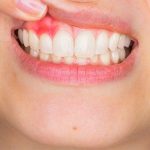 Inflammation of the periodontal supporting tissues of the teeth from gingiva into the adjacent bone and ligament. Usually a progressively destructive change leading to loss of bone and periodontal ligament.
Inflammation of the periodontal supporting tissues of the teeth from gingiva into the adjacent bone and ligament. Usually a progressively destructive change leading to loss of bone and periodontal ligament.
Is a severe form of gingivitis in which the inflammation of the gums extends to the supporting structures of the tooth. Also called pyorrhea.
Inflammation of the periodontal membrane; also called periodontitis simplex.
A serious gum infection that kills soft tissue and bones that support teeth.
Inflammation of the tissues surrounding and supporting the teeth.
Chronic inflammatory disease of the gums and bones around the teeth.
Inflammation of the area around a tooth.
An infection of the periodontal membrane leading to pyorrhoea, and resulting in the teeth falling out if untreated.
Inflammation or degeneration, or both, of the dental periosteum, alveolar bone, cementum, and adjacent gingiva. Suppuration usually occurs, supporting bone is resorbed, teeth become loose, and recession of gingivae occurs. This condition usually follows chronic gingivitis, Vincent’s infection, or poor dental hygiene. Systemic factors may also predispose one to this condition.
An advanced stage of gum disease in which the buildup of plaque and calculus causes the gum to pull away from the teeth and form pockets.
Periodontitis is a gum disease that leads to the deterioration of the structures responsible for supporting the teeth, which includes the bone.
Periodontitis refers to the inflammation of the periodontium, which includes the tissues encircling the teeth. This condition can manifest in two forms: periapical and marginal.
Periapical periodontitis arises due to untreated dental decay. When dental cavities are not addressed, enamel and the underlying dentine tissue can deteriorate, enabling bacteria to infiltrate the tooth pulp. These bacteria then extend to the root’s tip and nearby tissues, potentially leading to the development of an abscess, granuloma, or cyst.
Marginal periodontitis is a primary contributor to adult tooth loss. Stemming from untreated gingivitis, often linked to inadequate oral hygiene, this condition sees inflamed gum tissue near the tooth bases deteriorate, fostering the formation of pockets between gums and teeth. In these pockets, mucus, food particles, bacteria, and hardened plaque and saliva build up. The bacteria present in this accumulation target the periodontal tissues, prompting inflammation and detachment from the teeth. Over time, these bacteria erode the surrounding bone structure. Consequently, the teeth become unstable within their sockets and eventually become lost.
Periapical periodontitis can lead to a specific toothache, particularly when biting down. This condition could potentially harm the bone and periodontal ligaments, resulting in tooth instability. In more severe cases, a substantial dental cyst could prompt jaw swelling.
Marginal periodontitis is characterized by visible indications of gingivitis, including red, soft, glossy, and easily bleeding gums. This condition is accompanied by an unpleasant taste in the mouth and persistent bad breath. As the gum pockets deepen, the sensitive dentin in the tooth roots becomes exposed, leading to tooth discomfort when consuming hot, cold, or sweet substances. In some cases, there might be pus discharge from the gums or the formation of a periodontal abscess.
Periodontitis is diagnosed through a dental examination aimed at identifying pockets, evaluating their dimensions and depth, and dental X-rays used to detect any bone loss.
Treatment for periapical periodontitis involves draining the pus and either filling the tooth or opting for root canal treatment, a procedure that entails removing the decayed pulp from the tooth and its root, followed by filling the cavity. If the tooth is deemed irreparable, extraction is carried out.
In the initial phases of marginal periodontal disease, consistent and thorough teeth cleaning can prevent the further accumulation of plaque and calculus, thereby arresting the degradation of the tissues surrounding the teeth. For more advanced cases of periodontitis, the dentist will undertake plaque and calculus removal through scaling and root planing (smoothing the surface of exposed roots). In certain instances, a gingivectomy (surgical trimming of the gums) might be performed to reduce the size of gum pockets. Surgical intervention may also involve removing the diseased lining from the pocket, facilitating the reattachment of healthy underlying tissue to the tooth, and smoothing damaged, irregular bone. Loose teeth can occasionally be stabilized by a technique known as splinting.
Inflammation of the tissues around the tooth (periodontal tissues).
